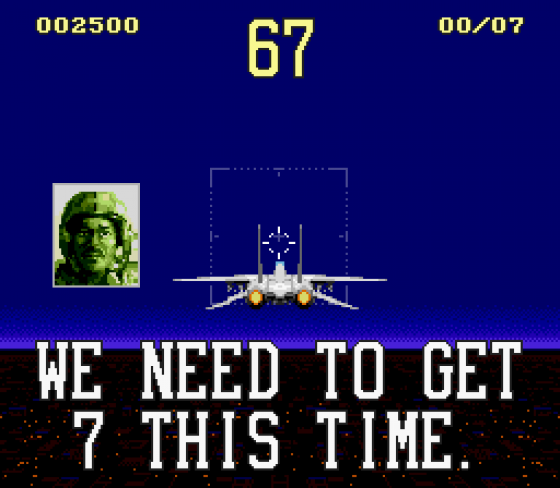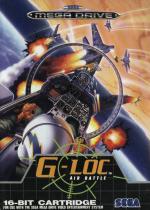
Mean Machines Sega
 1st March 1993
1st March 1993
Categories: Review: Software
Publisher: Sega
Machine: Sega Mega Drive (EU Version)
Published in Mean Machines Sega #6
How To Play
Fly your plane through each level of enemy territory, destroying air and ground targets, whilst avoiding missiles. Land on your carrier to restock in fuel and weapons.
G-Loc
Step back into the annals of aviation and look at the history of, not flight, but arcade flight simulators. Instead of picturing the daring young Wright brothers, launching their dreams at Kitty Hawk, think of Wayne and Kevin Wright, taking their lives into their hands down the local arcade. Many daring young pilots have shaken a tail-feather on the likes of 'Bomber' (1979), 'Red baron' (1980) and 'River Raid' (1981). It made little difference that these ancient games were cach. It was the Age of Adventure!
Nowadays, lots of hi-tech flight games, like G-LOC, are fighting for the privilege to regurgitate your dinner. They even go to the extent of building 360 degree spinning contraptions to house the screen.

Well, G-LOC on the Megadrive doesn't have the fancy hardware, but maintains the basic gameplay of the original, which is a never-ending supply of enemy fighters and bases to be shot down against a strict time limit. The state-of-the-art in arcade aviation is a carrier launched joyride of murder and mayhem. Enjoy.
Batches Of Butchery
G-LOC plays as a series of missions, split into sub-levels. A timer at the top of the screen counts down from 99, and the game ends if it reaches zero. The only way to get extended play is to shoot the required number of targets for each sub-level.
The requirement is announced by a digi-pic of the commanding officer, who thinks of an endless variety of ways to say the same thing: "10 incoming bogies, sir"; "We need twenty confirmed kills"; "Fifteen more targets", etc ad nauseam...
Big Bogies

Enemies come in two basic forms for the beginner to recognise - those with wings and those without. The winged ones fly in formation, and carry missiles and cannons. They fly out in front of your plane, then turn for a head-on attack.
Occasionally you may see a brightly coloured fighter. These are special squadron flyers, and downing them profers a bonus. The second breed of enemy has no wings. It sits in canyons and fires flak into the air, and is generally called a 'ground target'.
Base Briefs
Before you are launched on your mission, you have the option to view the terrain of each stage. An overhead map of the level is displayed across a viewing table. Pressing A zooms into a pixellated close-up of each section, with air encounters marked as triangles, ground targets marked as circles and the landing carrier marked with a square.
Rich

Well, this is a step backwards and no mistake. After Burner II is one of my favourite Megadrive games, but this is far, far worse. The one thing both of those games had in common was that they were very repetitive, but After Burner II made up for it with fast, exciting gameplay and loads of enemy 'planes on-screen at once.
G-LOC is quite a ponderous game, and the fact pace and excitement of After Burner II is lacking completely from this game, and the host of enemy targets for you to dodge or shoot is ludicrously small.
I agree completely with Gus - G-LOC is completely unexciting with no variation in the gameplay whatsoever. The coin-op's main pull was undoubtedly the hydraulics and the superb graphics. This Megadrive game has neither, so you're left with a shallow mockery of the original.

If you're desperate for an Afterburner game, After Burner II still rules supreme.
Gus
I find it disturbing that after three years of a machine's life, that programmers still haven't learned what can and cannot be done. G-LOC's big advantage is its timing: it came straight after the execrable After Burner III.
Although this is undoubtedly a better effort (It could hardly be worse!) it's still a bad game. The coin-op is ageing, but even when it was fresh it was a repetitive bore held up by its fancy scaling graphics and rotating cabinet.

Now the coin-op is old hat, and the Megadrive is pretty hopeless on the graphics and sound front in this conversion. The main letdown is the endless line of targets, the only difference coming in the phrases used to introduce them.
Players use a near endless supply of missiles, because aiming them up with the cannon is just too much trouble. In addition to this, the game features some really dire moments, like the shuddery columns around the sea convoy, that convince me it's not up to scratch.
Verdict
Presentation 73%
P. A fair amount of options, with different controls and skill levels.
N. Otherwise, there's nothing really outstanding about the game whatsoever.

Graphics 56%
P. Nicely drawn cockpit and 'planes. Sensible choice of colour schemes.
N. Lacks a real sense of movement. Sparse detail, and the graphics don't convey a realistic sense of light.
Sound 63%
P. The sound effects are adequate. Nice engine noises.
N. The music is very average, sounding like umpteen other Megadrive games. There is a serious lack of a good afterburner effect.
Playability 62%
P. More playable than Afterburner III. A gentle difficulty curve.
N. There's a limited variety of action, and a frustrating lack of control over the 'plane itself.
Lastability 45%
P. The game becomes challenging after the second mission.
N. The gameplay becomes monotonous within a short time. Not enough thought has gone into creating an interesting game.
Overall 52%
A backward step from Afterburner II. A total lack of variety and excitement means it's blander than Tom Cruise supping Malvern water.






